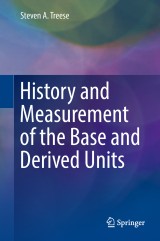Details

History and Measurement of the Base and Derived Units
|
149,79 € |
|
| Verlag: | Springer |
| Format: | |
| Veröffentl.: | 17.05.2018 |
| ISBN/EAN: | 9783319775777 |
| Sprache: | englisch |
Dieses eBook enthält ein Wasserzeichen.
Beschreibungen
<div><p>This book discusses how and why historical measurement units developed, and reviews useful methods for making conversions as well as situations in which dimensional analysis can be used.<br> It starts from the history of length measurement, which is one of the oldest measures used by humans. It highlights the importance of area measurement, briefly discussing the methods for determining areas mathematically and by measurement. The book continues on to detail the development of measures for volume, mass, weight, time, temperature, angle, electrical units, amounts of substances, and light intensity. The seven SI/metric base units are highlighted, as well as a number of other units that have historically been used as base units.</p>
<p>Providing a comprehensive reference for interconversion among the commonly measured quantities in the different measurement systems with engineering accuracy, it also examines the relationships among base units in fields such as mechanical/thermal, electromagnetic and physical flow rates and fluxes using diagrams.</p><br></div>
<p>Providing a comprehensive reference for interconversion among the commonly measured quantities in the different measurement systems with engineering accuracy, it also examines the relationships among base units in fields such as mechanical/thermal, electromagnetic and physical flow rates and fluxes using diagrams.</p><br></div>
Preface.- Measurement Perspectives.- Interconversion of Units.- Metric and U.S. Customary/English Systems.- Historical Length or Distance.- Historical Area.- Historical Volume or Capacity.- Historical Weight and Mass.- Historical Time.- Historical Temperature.- Historical Angular Measurement.- Historical Electrical Charge and Current Measurement.- Historical Amounts of Substances.- Historical Luminous Intensity.- From Base Units to Derived Units.- Common Modern Conversions.
<p>Steven Treese retired from Phillips 66 as the Hydroprocessing Team Lead in 2013; but continues to take on the occasional consulting assignment in process engineering and refining. He started his professional career with Union Oil Company of California in 1973 as a Research Engineer with a BS in Chemical Engineering from Washington State University. He followed company heritages through Unocal, Tosco, Phillips, ConocoPhillips, and Phillips 66. Steve’s range of experience includes hydroprocessing, hydrogen, operations, process safety, catalyst development, utilities, sulfur recovery, geothermal, shale oil, nitrogen fertilizers, process design, procurement, and licensing. </p>
<p>Steve is a licensed Professional Engineer with a handful of publications. He was on the 1994 NPRA Question and Answer Panel and was lead editor for the “Handbook of Petroleum Processing, 2<sup>nd</sup> Edition” (Springer, 2015). He has been an inventor on patents in diverse areas, including vessel internals, enhanced oil recovery, and hydroprocessing. He is a member of the American Institute of Chemical Engineers. </p>
<p>Steve’s hobbies include woodworking, boating, fermentation, robotics, and photography. He is a mentor for FIRST Robotics Team 3049 in Bremerton, WA, USA<br></p>
<p>Steve is a licensed Professional Engineer with a handful of publications. He was on the 1994 NPRA Question and Answer Panel and was lead editor for the “Handbook of Petroleum Processing, 2<sup>nd</sup> Edition” (Springer, 2015). He has been an inventor on patents in diverse areas, including vessel internals, enhanced oil recovery, and hydroprocessing. He is a member of the American Institute of Chemical Engineers. </p>
<p>Steve’s hobbies include woodworking, boating, fermentation, robotics, and photography. He is a mentor for FIRST Robotics Team 3049 in Bremerton, WA, USA<br></p>
<p>This book discusses how and why historical measurement units developed, and reviews useful methods for making conversions as well as situations in which dimensional analysis can be used.</p><p>It starts from the history of length measurement, which is one of the oldest measures used by humans. It highlights the importance of area measurement, briefly discussing the methods for determining areas mathematically and by measurement. The book continues on to detail the development of measures for volume, mass, weight, time, temperature, angle, electrical units, amounts of substances, and light intensity. The seven SI/metric base units are highlighted, as well as a number of other units that have historically been used as base units.</p><p>Providing a comprehensive reference for interconversion among the commonly measured quantities in the different measurement systems with engineering accuracy, it also examines the relationships among base units in fields such as mechanical/thermal, electromagnetic and physical flow rates and fluxes using diagrams.</p><p></p><p> </p><p> </p><p></p>
<p>Explores the overall development and evolution of measurement along with new perspectives to place measurement and units in an historical context</p><p>Provides origins and applications of the U.S. customary and English disparate systems of measurement and discusses why it is so difficult to change measurement systems</p><p>Introduces dimensional analysis and the “Factor-Label” approach, which helps ensure the final result from complex conversions is dimensionally consistent and reduces the likelihood of error in conversions involving multiple units and factors</p>

















